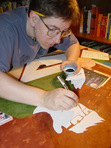Sue Clancy's Blog, page 54
October 19, 2016
loving dead feminists
Recently I took some of my artist books to the 23 Sandy Gallery in Portland Oregon. While I was there I saw the “Dead Feminists” exhibit by Jessica Spring and Chandler O’Leary. I’m talking exquisite hand drawn lettering, illustrations and printmaking employed as a way of celebrating women! And this exhibit also exists in a book titled Dead Feminists: Historical Heroines in Living Color published by Sasquatch Books.
Naturally I bought a copy.
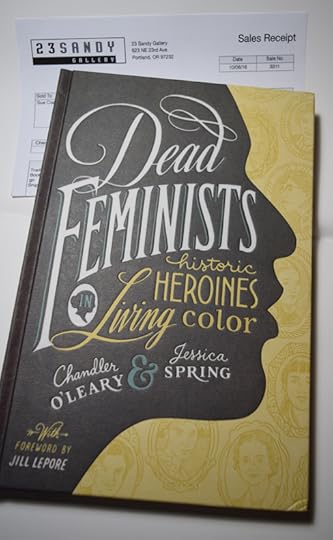
My copy of Dead Feminists – you can get your own here: http://www.deadfeminists.com/
The book – which you can purchase via their website http://www.deadfeminists.com/ and probably by book-sellers where-ever – is a wonderful nesting, interlocking set of artistic ideas. There’s the historical stuff about women (those dead feminists) who have done exceptional work towards advancing women’s rights. There’s the stuff about how artist’s Spring and Chandler worked to create the lettering, illustrations and the print production. Then there’s the stuff about what non-profit organizations (often women’s orgs) benefited from the sales of Spring and Chandler’s artwork.
It’s a beautiful depiction of how an artist (and a woman in whatever profession) can do her best work and benefit her community both immediately and in the future.
The book is a powerful reminder that we are each an essential contributor to life as we know it – or hope to know it.
Thank you Jessica Spring and Chandler O’Leary for your wonderful work! And thank you 23 Sandy Gallery for sharing it!
Now that I’ve finished reading this book I’ll go fetch my socks from where-ever they went when they were blown off.

October 17, 2016
best artistic life trick
When I went to art school I didn’t know how to cook. Art school was expensive and the rough average materials costs to do my “homework” were about $30. (in late 1980’s dollars in Oklahoma) for each homework assignment in each class. There was major homework each week, for at least one class – usually more – so costs added up. After spending money on art supplies there wasn’t much left over for food. I ate a lot of baloney and cheese sandwiches on white bread.
In my freshman year I had been approved to have a studio space in the art studio building. One had to submit a portfolio and be approved by a panel of professors. Competition was fierce. Consequently most of the students approved for studio space were juniors and seniors. Some of them were also “returning students” aka “old people” in their late 20’s or 30’s
And then there was me. I was known as “The Kid”.
In the studio building there was a communal kitchen, with a refrigerator, small stove, a coffee pot and a large table and a number of chairs.
One day I was in the kitchen at the table eating my baloney and cheese. Two of the older female students (both from California) entered, rummaged in the fridge, heated something on the stove, then sat to eat a veritable feast of black bean soft tacos with sauteed chilies, onions, spinach and cheese.
I stared. And probably drooled.
One of them looked over at me “Hey kid, what are you eating?”
I told them.
“Oh, gross!” said the other California girl “That’s disgusting!”
I asked what they were eating, they told me, and offered bites …. one thing led to another and pretty soon I was meeting regularly with them and about 6 of their friends for pot-luck dinners.
Before each pot-luck one of the members would demonstrate how to cook the dish they were sharing that evening. I went to almost every cooking lesson. (And I contributed to the events by doing a lot of the clean-up.)
Almost every one of the pot-luck club members were artist’s of one sort or another. Many dinner discussions were about “the business of being an artist” including how important it was for artists to be able to cook (and mix your own alcoholic drinks) because it fed creative brains more nutritionally – and helped an artist be able to afford to do creative work and live well.
I soaked it up like a sponge, learned how to cook and have probably survived as a professional artist because of what I’ve learned about cooking and business from those California girls.
The “how to cook dry beans” was a regular cook-lesson topic as dry beans (available in a bag dry or from bulk bins) are much cheaper than canned. Once you’ve a big pot of cooked beans ready-to-eat they can be stored in a fridge and quickly used over the coming days for soft taco’s, burrito’s, soups and salads – and more. All cheap fairly quick eats that are yummy!
Of all the lessons I learned “The Beans” was the best and the most useful trick to living the artistic/creative life well! I’m even using the “bean cooking” technique this very day !
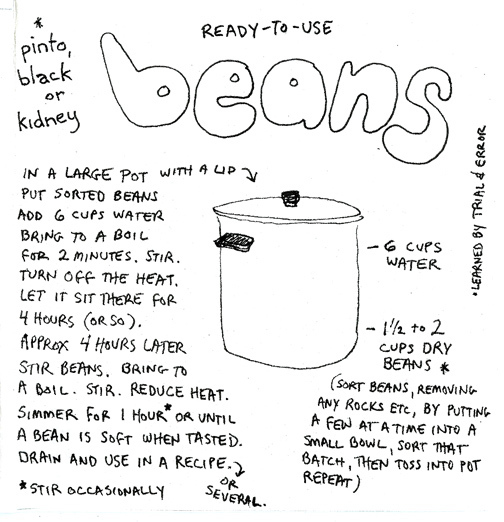
Sue’s “how to cook dry beans” sketchbook page
These days I use a fancy bean pot – made from iMusa – and it is an improvement on the old large stock pot method I used back then. My bean pot uses 8 cups of water – and can hold 3 cups of dry beans…. But the large-stock-pot method described in my sketchbook page above still works great too. Anyway here’s a picture of my bean pot in action right now (I started the pot at 10:52… and it’s starting to smell good about now!):

Sue’s Magic Bean cooking pot at work.
When my art-studio work day is done later today I’m looking forward either to some bean+chili+cheese burritos…or else some nachos. Hard to choose… Anyway, do you want my recipe for “artist” burrito’s or nachos too?

self-portrait of the artist
Here’s a self-portrait I did this morning. (Aka: more short visual story/narrative practice.)

Self-portrait of the artist this morning. By Sue Clancy

October 15, 2016
drawing on grandmas pillow
As a kid I remember drawing on almost anything I could. In self defense my Grandmother kept a stack of paper, pencils and a few crayons in her kitchen and encouraged me to stick to those surfaces. Oh, and there was a small blackboard with some color chalk.
I loved those materials but now and then I strayed; I drew in chalk on the wall, the porch and the sidewalk, I drew with sticks in the mud, I drew on paper napkins, I drew with berries in the kitchen sink, I drew with a blue crayon on a pillow case.
I think the blue crayon on the white pillow case upset Grandma the most.
So let’s just say that after the “pillow case incident” I got the message about staying on paper or chalkboards.
Mostly.
Until now.
Recently (as an adult professional artist I might add) I’ve had the opportunity to do some pattern designs for pillows! White luscious pillows covered with my art! Childhood dreams do come true! Or perhaps people now-a-days are simple more okay with me drawing on the pillows? http://www.shopvida.com/collections/sue-clancy
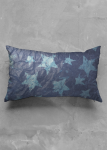
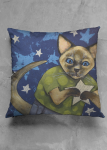
You can see a video of me making the blue star pattern on YouTube: https://youtu.be/cAx88mwARqo

October 14, 2016
the art of spitting seeds
I was looking in my files for some dog photos and found this graphic narrative I’d written and drawn some time ago. Since I’ve recently been practicing my “short narrative/ flash fiction/ nonsense” on this blog I thought you’d enjoy seeing this effort too!

A short autobiographical graphic narrative by Sue Clancy

October 12, 2016
seeing art in autumn leaves
I’ve 2 different one-woman art exhibits already scheduled for 2017 – and already there’s discussion of another exhibit for 2018. So I’ve been taking walks to gather inspiration. Which means lots of sketchbook work, doodling and experimenting with pattern designs. Here’s a sketch I did along the River-walk in Vancouver…

Sue Clancy’s sketchbook page; ink and watercolor done on location as she walked.
Also in my sketchbook I did some ink and watercolor drawings of some of the fallen leaves during that same walk. You can see that sketch along with a pattern-design tile I was working on in this photo here:

Sue Clancy’s sketchbook page and a pattern design “tile” she was creating using cut handmade paper.
And here are photos of a pocket square, a scarf and a tote bag I created using my “Autumn Leaves” pattern design as part of my art apparel collection: http://shopvida.com/collections/sue-clancy
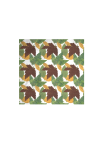
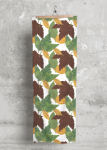
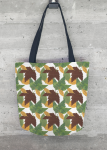
Now I’m thinking and re-thinking this overall-leaf motif and how it may relate to my paper-making techniques. I’m also plotting how to use this design – or variations on it – in future fine artworks.
Between now and the actual paper creation there will be more walks and more sketches of leaves (and probably other things). I saw some beautiful ginkgo tree’s downtown the other day…
Yes, this is a long-term project. But, don’t worry, there will be breaks for lunch.

October 10, 2016
more short nonsense
Practicing “narrative” additions to my “visual story” thing – and this time I illustrated a short short-poem-story-like-substance. Please wash your hands after handling (ahem, wink) this one titled:
Haste Accounting by Sue Clancy
An accountant was working in Haste
who added his numbers with paste
saying “If these sums are wrong
then I’ll sing you a song
but there’s simply no accounting for taste.”

illustration for “Haste Accounting” a poem written and illustrated by Sue Clancy

the art of short nonsense
I’ve decided I’m going to practice adding more “narrative” information on occasion to the “visual story” thing I do. Particularly when I’m doing my artist books. So, lucky you, you’ll get to watch me practice in public! Here’s a short, short bit of flash-fiction-y nonsense to start with:
Scary Spider Story by Sue Clancy

Scary Spider Story by Sue Clancy

October 7, 2016
Irish art and pub food
Long ago now I was in an art exhibit in Wexford Ireland (my last name is Clancy, in case you’re wondering about the Irish connection). Communications regarding shipping my artwork to the Wexford Ireland Arts Centre http://www.wexfordartscentre.ie/ – happened via email and chat. Anyway, at one point the director said that he was going to go get a bowl of “Dublin Coddle” and would be back shortly. I replied “Great, talk more soon… and when you get a chance; what is ‘Dublin Coddle’?”
A bit later my food-education arrived via email: Dublin Coddle is a traditional Irish stew, almost every Irish family has “their” version of it and almost every Irish pub has “their” version and it’s a sort of stew that is easy to make and gets better the longer it cooks.
Mr. Collins kindly shared his version of a Dublin Coddle recipe – which used Irish Sausage. I haven’t been able to find Irish Sausage for sale at a grocers here in the U.S. tho I have had some great Irish Sausages in some local Pacific Northwest Irish pubs – but I’ve had good success with the good quality sausages I can find.
I’ve been grateful to Mr. Collins, for many years, for sharing his recipe and by now I’ve developed my own version. I find it’s easy to chop ingredients, throw ’em in a pot of a morning, then get to work in my art studio. Only occasionally do I go to the kitchen to stir the stew. Whenever I’m ready to stop my studio work and eat – it’s yummy, warm and feels like home! And the leftovers are even better!
Here’s my recipe:
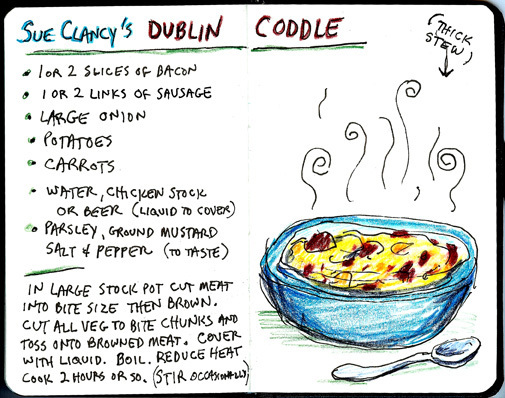
page from “Coffee, Table, Book” https://store.bookbaby.com/book/coffee-table-book

October 5, 2016
Sue’s art speech text
On Oct 1st I gave a short talk during my fine art opening at the Daily In The Pearl arranged by Caplan Art Designs. Since I’d recently written a blog post titled “on writing and giving speeches” I thought it only fair to share with you the text of my speech along with photos. This is a rough approximation of what I said as I can’t re-create the ad-libs and audience participation – it was a fun lively evening! Anyway here goes:
Speech given Oct 1st 2016 by Sue Clancy
Thank you for coming!
I create mixed media handmade paper collage. I start off with white handmade paper and I give that paper color and pattern using a variety of art techniques; I dye the paper, I stencil it, I print on it, I marble it and use a variety of other methods. This is the “mixed media” aspect of my work.
Here are a few scraps of papers I’ve done so you can handle them, along with a postcard containing photos of me in action.

Paper samples Sue Clancy handed out during her speech; the paper on the far left is an example of the white paper she starts out with – the other 3 are examples of color/pattern she’s given the white paper

Postcard Sue made, and handed out during her speech, that shows photos of her giving paper color and pattern.
Once the papers are dry I take an X-acto knife and cut shapes out of them. Then I take the cut-paper-shapes and glue them together to make my art images. There are layers of paper glued on top of other papers. Yes, tweezers are involved.
In “The Read Hat” I cut the chihuahua’s head, 4 paws and tail out of a medium brown paper – then other smaller shapes of darker/lighter brown papers were cut to make his face. The clothes the dog wears was cut out of a green dotted paper, the books out of yellow papers – and so forth – until the image was finished.
That’s my construction method.

“The Read Hat” By Sue Clancy 14 x 11 x 2 inches Hand dyed paper, handmade paper, hand stenciled paper, found paper and acrylic on cradled board
My ideas and the pattern designs within them come from my life. Take “The Read Hat” as an example again; 5 different life experiences went into this concept.
I saw some wet, weathered flyers stapled on some telephone poles during a walk on Hawthorne Street in Portland Or. the pattern of letters overlaying each other transparently made me think about the clarity and legibility of information. (This inspired the background of this artwork.)
I met a Chihuahua who has the habit of collecting most things found at floor level onto his dog bed. Yet he still showed a preference for some things over others. So I began thinking about how I have to select which information in the world to spend time trying to understand since it is impossible to “collect all” the available information.(This inspired my choice of a Chihuahua character)
On a trip to the Oregon Coast I drove through Oregon wine country. The hills rise and fall so in several places I had an almost aerial view of the Oregon vineyards. (That inspired the green dotted pattern the Chihuahua is wearing.)
The “aerial view” of an Oregon vineyard reminded me of my favorite self-indulgence; I like to put on my pj’s early of an evening, have a glass of wine and read a book for an hour or so before bed. (This is why the character is wearing pj’s and not some other sort of outfit)
When I indulge myself this way I often take off my hearing-aids so as to completely relax and focus on what I’m reading. My deafness made me think of how important language is as a framework for understanding the world. Language is a container, a hat, that holds knowledge.
This is generally how I work: pattern designs become symbols in a visual story. When I do special commissions I use this visual story method too – only instead of my life experiences inspiring the pattern designs and story symbols it’s your life experiences that do that.
The titles I give my artworks, the “blurbs” and statements I write about them – or about my exhibits – are clues to my personal thoughts. But my use of pattern design symbolically and my use of the Animals in Art genre (it’s a classic genre of fine art like ‘still life’ or ‘landscape painting’) takes my work beyond the personal and into the mythological story or fable.
So this summer when a San Francisco company contacted me about licensing my designs for use as scarves, bags and other apparel I saw a chance to extend my ‘pattern designs as symbols’ concept into the real world. You can see my full apparel collection here: http://www.shopvida.com/collections/sue-clancy
Using the same pattern design in multiple symbolic ways – in different fine artworks, in art apparel and in artist books – is my way of thinking about aspects of nature, culture and other things in contemporary life. Thank you!
Here’s a photo of me giving the above speech.

Sue Clancy giving a short speech about her artwork


